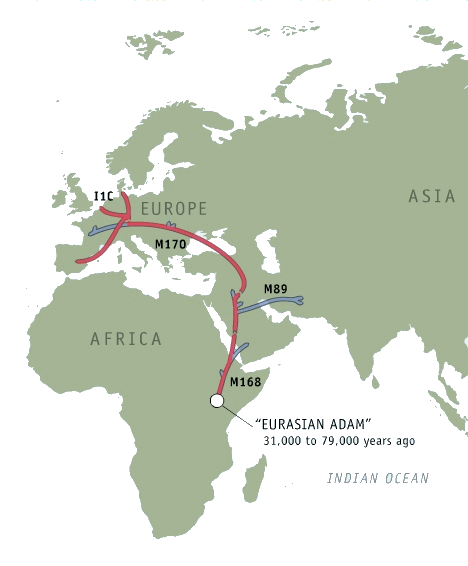The Journey Out of Africa
Haplogroup
I1c (M223)

The results of Y-chromosome testing identifies Thomas Egginton b1793 in Wolverhampton as a member of haplogroup I1c. If you are a descendant of his then these notes relate to your ancestry.
The genetic markers that define your ancestral history reach back roughly 60,000 years to the first common marker of all non-African men, M168, and follow your lineage to present day, ending with M223, the defining marker of haplogroup I1c.
If you look at the map highlighting your ancestors' route, you will see that members of haplogroup I1c carry the following Y-chromosome markers:
Haplogroup, I1c, is most common in Germany. About 11 percent of all German men belong to this genetic lineage.
What's a haplogroup, and why do geneticists concentrate on the Y-chromosome in their search for markers? For that matter, what's a marker?
Each of us carries DNA that is a combination of genes passed from both our mother and father, giving us traits that range from eye color and height to athleticism and disease susceptibility. One exception is the Y-chromosome, which is passed directly from father to son, unchanged, from generation to generation.
Unchanged, that is unless a mutation - a random, naturally occurring, usually harmless change - occurs. The mutation, known as a marker, acts as a beacon; it can be mapped through generations because it will be passed down from the man in whom it occurred to his sons, their sons, and every male in his family for thousands of years.
In some instances there may be more than one mutational event that defines a particular branch on the tree. This is the case for your haplogroup I, since this branch can be defined by two markers, either M170 or P19. This means that either of these markers can be used to determine your particular haplogroup, since every individual who has one of these markers also has the other. Therefore, either marker can be used as a genetic signpost leading us back to the origin of your group, guiding our understanding of what was happening at that early time.
When geneticists identify such a marker, they try to figure out when it first occurred, and in which geographic region of the world. Each marker is essentially the beginning of a new lineage on the family tree of the human race. Tracking the lineages provides a picture of how small tribes of modern humans in Africa tens of thousands of years ago diversified and spread to populate the world.
A haplogroup is defined by a series of markers that are shared by other men who carry the same random mutations. The markers trace the path your ancestors took as they moved out of Africa. It's difficult to know how many men worldwide belong to any particular haplogroup, or even how many haplogroups there are, because scientists simply don't have enough data yet.
One of the goals of the five-year Genographic Project was to build a large enough database of anthropological genetic data to answer some of these questions. To achieve this, project team members are traveling to all corners of the world to collect more than 100,000 DNA samples from indigenous populations. In addition, we encourage you to contribute your anonymous results to the project database, helping our geneticists reveal more of the answers to our ancient past.